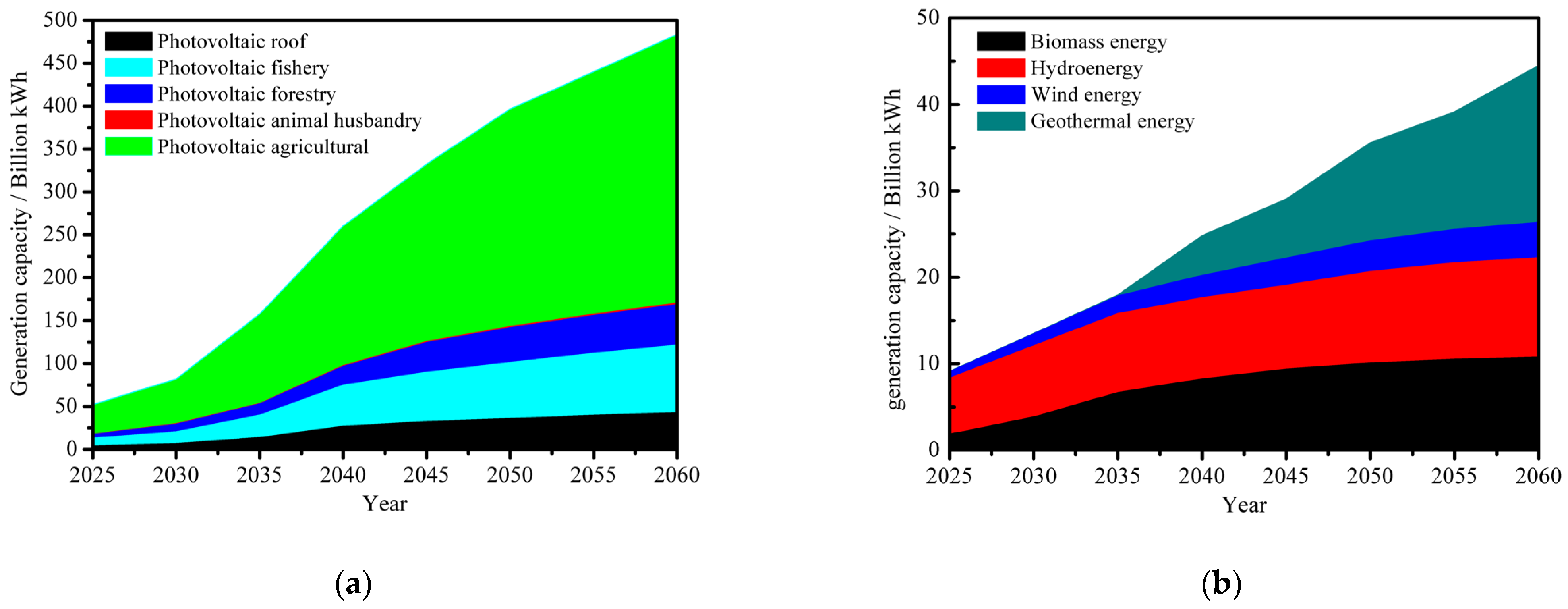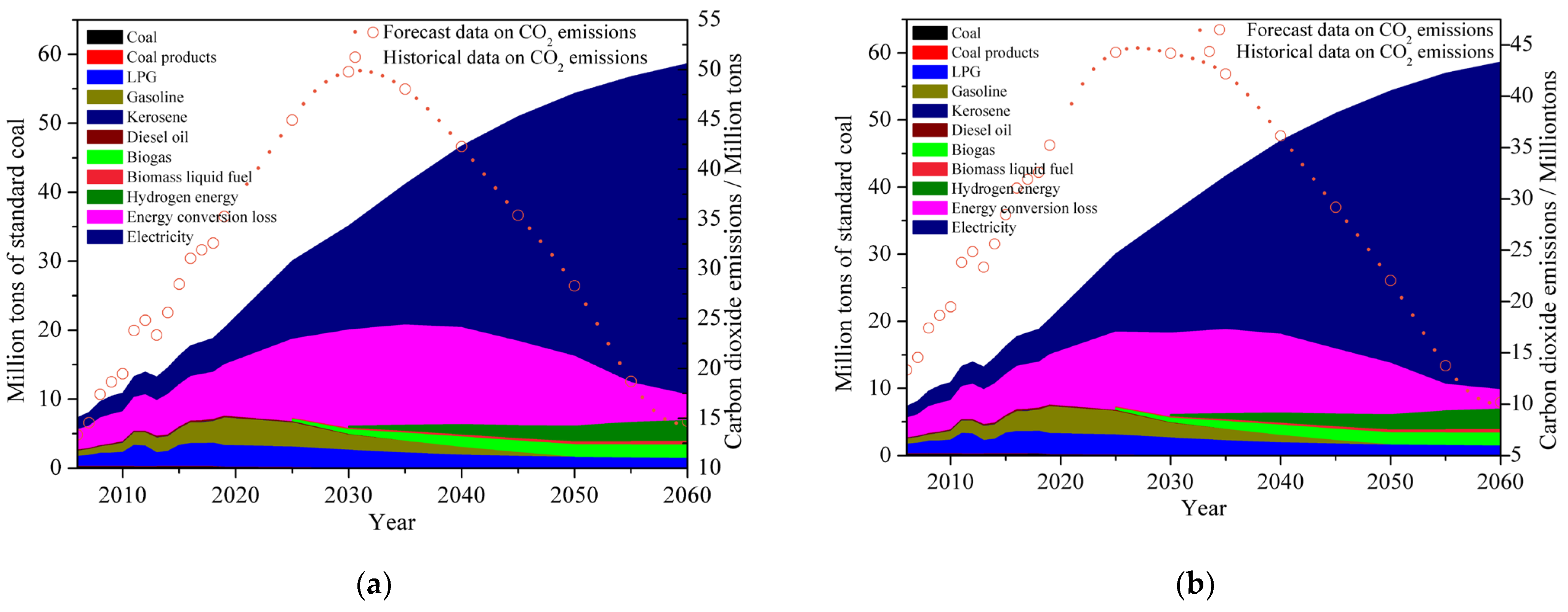Study on Carbon Emission Pathways in the Rural Areas of Guangdong Province
Abstract
:1. Introduction
2. Energy Supply and Demand in Guangdong
2.1. Rural Energy Production and Consumption in Guangdong
2.2. Forecasting Methods of Rural Energy Consumption in Guangdong
3. Development Status and Forecast of Rural Renewable Energy in Guangdong
3.1. Development Potential of Renewable Energy
3.2. Forecasting Methods of Rural Energy Supply in Guangdong
4. Analysis of the “Peak Carbon Dioxide Emission” and “Carbon Neutrality” Pathways in the Rural Areas of Guangdong
4.1. Analysis of the “Peak Carbon Dioxide Emission” and “Carbon Neutrality” Pathways for Rural Household Energy Consumption
4.2. Analysis of the “Peak Carbon Dioxide Emission” and “Carbon Neutrality” Pathways for Rural Energy Production
5. Conclusions
Author Contributions
Funding
Data Availability Statement
Conflicts of Interest
References
- Bruckner, B.; Hubacek, K.; Shan, Y.; Zhong, H.; Feng, K. Impacts of poverty alleviation on national and global carbon emissions. Nat. Sustain. 2022, 5, 311–320. [Google Scholar] [CrossRef]
- Zeqiong, X.; Xuenong, G.; Wenhui, Y.; Jundong, F.; Zongbin, J. Decomposition and prediction of direct residential carbon emission indicators in Guangdong Province of China. Ecol. Indic. 2020, 115, 106344. [Google Scholar] [CrossRef]
- Wang, W.; Zhao, D.; Kuang, Y. Decomposition analysis on influence factors of direct household energy-related carbon emission in Guangdong province-Based on extended Kaya identity. Environ. Prog. Sustain. Energy 2016, 35, 298–307. [Google Scholar] [CrossRef] [Green Version]
- Hu, A. China’s Goal of Achieving Carbon Peak by 2030 and Its Main Approaches. J. Beijing Univ. Technol. 2021, 21, 3. [Google Scholar]
- Zhao, H.; Hu, J.; Hao, F.; Zhang, H. Determinants of Carbon Dioxide Emissions and Their Peaking Prospect: Evidence From China. Front. Environ. Sci. 2022, 10, 913835. [Google Scholar] [CrossRef]
- Deangelo, J.; Azevedo, I.; Bistline, J.; Clarke, L.; Luderer, G.; Byers, E.; Davis, S.J. Energy systems in scenarios at net-zero CO2 emissions. Nat. Commun. 2021, 12, 6096. [Google Scholar] [CrossRef] [PubMed]
- Ye, H.; Cheng, L.; He, J.; Dang, Z.; Chao, J.; Tan, C. Exploration of Guangdong Rural Distributed Photovoltaic Construction Model from the Perspective of "Innovative Carbon-Neutral Rural Area". South Archit. 2021, 4, 74–81. [Google Scholar]
- Zhang, S.; Chen, W. Assessing the energy transition in China towards carbon neutrality with a probabilistic framework. Nat. Commun. 2022, 13, 87. [Google Scholar] [CrossRef] [PubMed]
- Ma, X.; Wang, C.; Dong, B.; Gu, G.; Chen, R.; Li, Y.; Zou, H.; Zhang, W.; Li, Q. Carbon emissions from energy consumption in China: Its measurement and driving factors. Sci. Total. Environ. 2019, 648, 1411–1420. [Google Scholar] [CrossRef] [PubMed]
- Ren, J.; Yang, Y.; Chi, Y. Research on Straw-Based High-Quality Energy in China under the Background of Carbon Neutrality. Energies 2022, 15, 1724. [Google Scholar] [CrossRef]
- Zhang, X.; Xu, K.; He, M.; Wang, J. A Review on the Rural Household Energy in China From 1990s—Transition, Regional Heterogeneity, Emissions, Energy-Saving, and Policy. Front. Energy Res. 2022, 10, 907803. [Google Scholar] [CrossRef]
- Li, J.; Chen, C.; Liu, H. Transition from non-commercial to commercial energy in rural China: Insights from the accessibility and affordability. Energy Policy 2019, 127, 392–403. [Google Scholar] [CrossRef]
- Guangdong Rural Statistical Yearbook. Available online: https://data.cnki.net/yearbook/Single/N2022020097 (accessed on 31 February 2022).
- China Energy Statistical Yearbook 2020. Available online: https://data.cnki.net/yearbook/Single/N2021050066 (accessed on 31 May 2021).
- Wang, Y.; Yang, G.; Dong, Y.; Cheng, Y.; Shang, P. The Scale, Structure and Influencing Factors of Total Carbon Emissions from Households in 30 Provinces of China—Based on the Extended STIRPAT Model. Energies 2018, 11, 1125. [Google Scholar] [CrossRef] [Green Version]
- Guangdong Statistical Yearbook. Available online: https://data.cnki.net/Yearbook/Single/N2020110011 (accessed on 31 January 2020).
- Ribeiro, H.V.; Rybski, D.; Kropp, J.P. Effects of changing population or density on urban carbon dioxide emissions. Nat. Commun. 2019, 10, 3204. [Google Scholar] [CrossRef] [PubMed] [Green Version]
- Pehl, M.; Arvesen, A.; Humpenöder, F.; Popp, A.; Hertwich, E.G.; Luderer, G. Understanding future emissions from low-carbon power systems by integration of life-cycle assessment and integrated energy modelling. Nat. Energy 2017, 2, 939–945. [Google Scholar] [CrossRef]
- Yeh, S.; Mishra, G.S.; Morrison, G.; Teter, J.; Quiceno, R.; Gillingham, K.; Riera-Palou, X. Long-term shifts in life-cycle energy efficiency and carbon intensity. Environ. Sci. Techno.l 2013, 47, 2494–2501. [Google Scholar] [CrossRef] [PubMed]
- Weisser, D. A guide to life-cycle greenhouse gas (GHG) emissions from electric supply technologies. Energy 2007, 32, 1543–1559. [Google Scholar] [CrossRef]
- 2019 Refinement to the 2006 IPCC Guidelines for National Greenhouse Gas Inventories. Available online: https://www.ipcc-nggip.iges.or.jp/public/2019rf/index.html (accessed on 1 January 2019).











| Number of Household Water Heater | Number of Vehicles | Household Electrical Appliances | Average Disposable Income | Energy Consumption Per capita | Population | Household Energy Consumption | |
|---|---|---|---|---|---|---|---|
| Household energy consumption | 0.992 ** | 0.971 ** | 0.994 ** | 0.986 ** | 0.998 ** | −0.716 ** | 1 |
| Population | −0.773 ** | −0.840** | 0.682 ** | −0.656 ** | −0.750 ** | 1 | |
| Energy Consumption per capita | 0.997 ** | 0.978** | 0.991 ** | 0.985 ** | 1 | ||
| Average disposable income | 0.981 ** | 0.933 ** | 0.989 ** | 1 | |||
| Household electrical appliances | 0.987 ** | 0.957 ** | 1 | ||||
| Number of vehicles | 0.982 ** | 1 | |||||
| Number of household water heater | 1 |
| Fishery Area | Gross Output Value of Agriculture | Tea Garden Area | Orchard Area | Vegetable Area | Agricultural Sown Area | People Employed in Primary Industry | Rural Mechanical Power | Irrigation Area | Energy for Production | |
|---|---|---|---|---|---|---|---|---|---|---|
| Energy for production | −0.650 * | 0.918 ** | 0.831 ** | 0.216 | 0.628 ** | −0.650 ** | −0.843 ** | 0.708 ** | 0.557* | 1 |
| Irrigation area | −0.158 | 0.708 ** | 0.440 | 0.232 | 0.188 | −0.705 ** | −0.743 ** | 0.853 ** | 1 | |
| Rural mechanical power | −0.223 | 0.875 ** | 0.615 ** | 0.093 | 0.414 | −0.801 ** | −0.901 ** | 1 | ||
| People employed in primary industry | 0.433 | −0.959** | −0.854 * | 0.015 | −0.630 ** | 0.677 ** | 1 | |||
| Agricultural sown area | 0.446 * | −0.746 ** | −0.361 | −0.267 | −0.197 | 1 | ||||
| Vegetable area | −0.326 | 0.679 ** | 0.801 ** | −0.285 | 1 | |||||
| Orchard area | −0.268 | 0.089 | −0.061 | 1 | ||||||
| Tea garden area | −0.589 * | 0.868 ** | 1 | |||||||
| Gross output value of agriculture | −0.534 * | 1 | ||||||||
| Fishery area | 1 |
| Energy | Carbon Emissions Coefficient |
|---|---|
| Kerosene | 3.1079 kgCO2/kg |
| LPG | 3.1013 kgCO2/kg |
| Coal | 1.9003 kgCO2/kg |
| Gasoline | 2.9251 kgCO2/kg |
| Diesel oil | 3.0959 kgCO2/kg |
| Electric energy production | 0.997 kgCO2/kWh |
| Energy | Conversion Factor |
|---|---|
| Raw coal | 0.714 kgce/kg |
| Crude oil | 1.4286 kgce/kg |
| Gasoline | 1.4714 kgce/kg |
| Kerosene | 1.4714 kgce/kg |
| Diesel | 1.4571 kgce/kg |
| Liquefied petroleum gas | 1.7143 kgce/kg |
| Natural gas | 1.1000–1.3300 kgce/cu.m |
| Electricity | 0.1229 kgce/kWh |
| Biogas | 0.714 kgce/cu.m |
| Hydrogen energy | 0.4361 kgce/cu.m |
Publisher’s Note: MDPI stays neutral with regard to jurisdictional claims in published maps and institutional affiliations. |
© 2022 by the authors. Licensee MDPI, Basel, Switzerland. This article is an open access article distributed under the terms and conditions of the Creative Commons Attribution (CC BY) license (https://creativecommons.org/licenses/by/4.0/).
Share and Cite
Tang, Z.; Li, D.; Guo, H. Study on Carbon Emission Pathways in the Rural Areas of Guangdong Province. Energies 2022, 15, 8886. https://doi.org/10.3390/en15238886
Tang Z, Li D, Guo H. Study on Carbon Emission Pathways in the Rural Areas of Guangdong Province. Energies. 2022; 15(23):8886. https://doi.org/10.3390/en15238886
Chicago/Turabian StyleTang, Zhihua, Dianhong Li, and Huafang Guo. 2022. "Study on Carbon Emission Pathways in the Rural Areas of Guangdong Province" Energies 15, no. 23: 8886. https://doi.org/10.3390/en15238886





